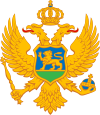Montenegrins of Serbia
This biography of a living person needs additional citations for verification. (January 2019) |
 Flag of the National Council of the Montenegrin Minority in Serbia | |
| Total population | |
|---|---|
| 38,527 (2011) | |
| Regions with significant populations | |
| 22,141 (1.15%) | |
| 9,902 | |
| Languages | |
| Serbian or Montenegrin[1] | |
| Religion | |
| Eastern Orthodoxy | |
| Related ethnic groups | |
| Serbs | |
The Montenegrins of Serbia (Serbian: Црногорци у Србији, romanized: Crnogorci u Srbiji) are a national minority in the country. According to the 2011 census, there are 38,527[2] ethnic Montenegrins in Serbia. They are the sixth largest ethnic community in the Vojvodina province.
Geography[]
The largest concentration of Montenegrins in Vojvodina could be found in the municipalities of Vrbas (24.79%), Mali Iđoš (20.83%), and Kula (16.34%). Settlements in Vojvodina with an absolute or relative Montenegrin majority are: Lovćenac in the Mali Iđoš municipality with 56.86% Montenegrins, Kruščić in the Kula municipality with 32.64%, and Montenegrins in Savino Selo in the Vrbas municipality with 38.20% Montenegrins. Formerly, the village of Bačko Dobro Polje in the Vrbas municipality also had a Montenegrin majority (According to the 1971 census, Montenegrins comprised 55.39% of population of this village, while according to the 2002 census, the current population of the village is composed of 57.17% Serbs and 38.18% Montenegrins. Also, Montenegrins in Sivac in the Kula municipality had a Montenegrin majority in the 1970's, now they have a sizable minority population of 30.06% according to the 2002 census.
Demographics[]

| Part of a series on |
| Montenegrins |
|---|
 |
| By region or country |
| Recognized populations |
|
Montenegro Serbia Bosnia and Herzegovina Croatia North Macedonia Kosovo Albania |
|
Europe · · · Germany · Luxembourg · Slovenia · |
|
North America United States · Canada · |
|
South America Argentina · · · |
|
Oceania Australia · |
| Culture |
|
Literature · Music · · Cinema Cuisine · · Sport |
| Religion |
|
Catholicism Islam |
| Language and dialects |
| Montenegrin · Serbian |
| History |
|
History of Montenegro Rulers |
| Year | Montenegrins | % |
|---|---|---|
| 1948 | 74,860 | 1.15% |
| 1953 | 86,061 | 1.23% |
| 1961 | 104,753 | 1.37% |
| 1971 | 125,260 | 1.48% |
| 1981 | 147,466 | 1.58% |
| 1991 | 139,299 | 1.42% |
| 1991 (excl. Kosovo) | 118,934 | 1.52% |
| 2002 (excl. Kosovo) | 69,049 | 0.92% |
| 2011 (excl. Kosovo) | 38,527 | 0.5% |
In Vojvodina, the number of Montenegrins, according to 1948-2011 censuses: 1948: 30,589 (1.9%); 1953: 30,516 (1.8%); 1961: 34,782 (1.9%); 1971: 36,416 (1.9%); 1981: 43,304 (2.1%); 1991: 47,289 (2.3%); 2002: 35,513 (1.75%); 2011: 22,141 (1.15%).
Culture[]
Montenegrins in Serbia speak Serbian/Montenegrin and the vast majority are adherents of the Serbian Orthodox Church. The society of Montenegrins in Serbia, known as "Krstaš", is based in Lovćenac. Montenegrin language was recognised as minority language in official use in Mali Iđoš.[3]
Notable people[]
- Mihailo Janketić, actor[4]
- Nenad Stevović, politician, publicist, political scientist and a researcher
See also[]
- Ethnic groups of Vojvodina
- Montenegrin Party
Sources[]
- ^ "Nacionalni savjet crnogorske nacionalne manjine".
- ^ "Попис у Србији 2011".
- ^ B92: Crnogorski jezik u Malom Iđošu (Montenegrin language in Mali Iđoš) (in Serbian)
- ^ Serbia, RTS, Radio televizija Srbije, Radio Television of. "Miša Janketić – njegovi domovi bili su kuća i bina". www.rts.rs. Retrieved 2022-02-01.
External links[]
- Ethnic groups in Serbia
- Ethnic groups in Vojvodina

